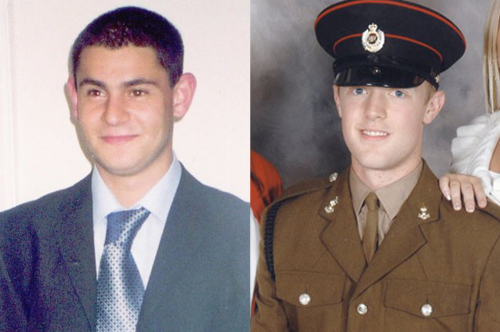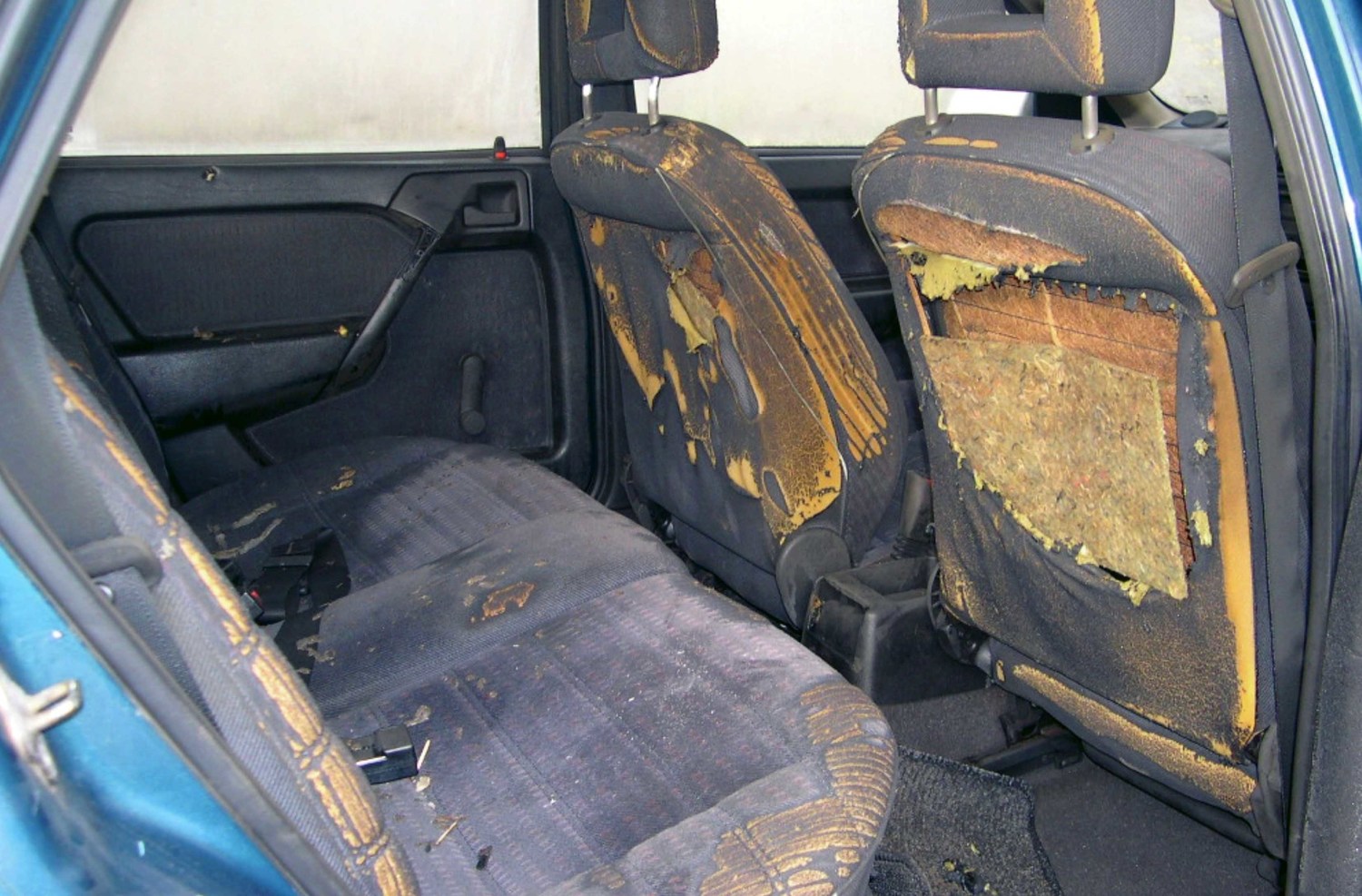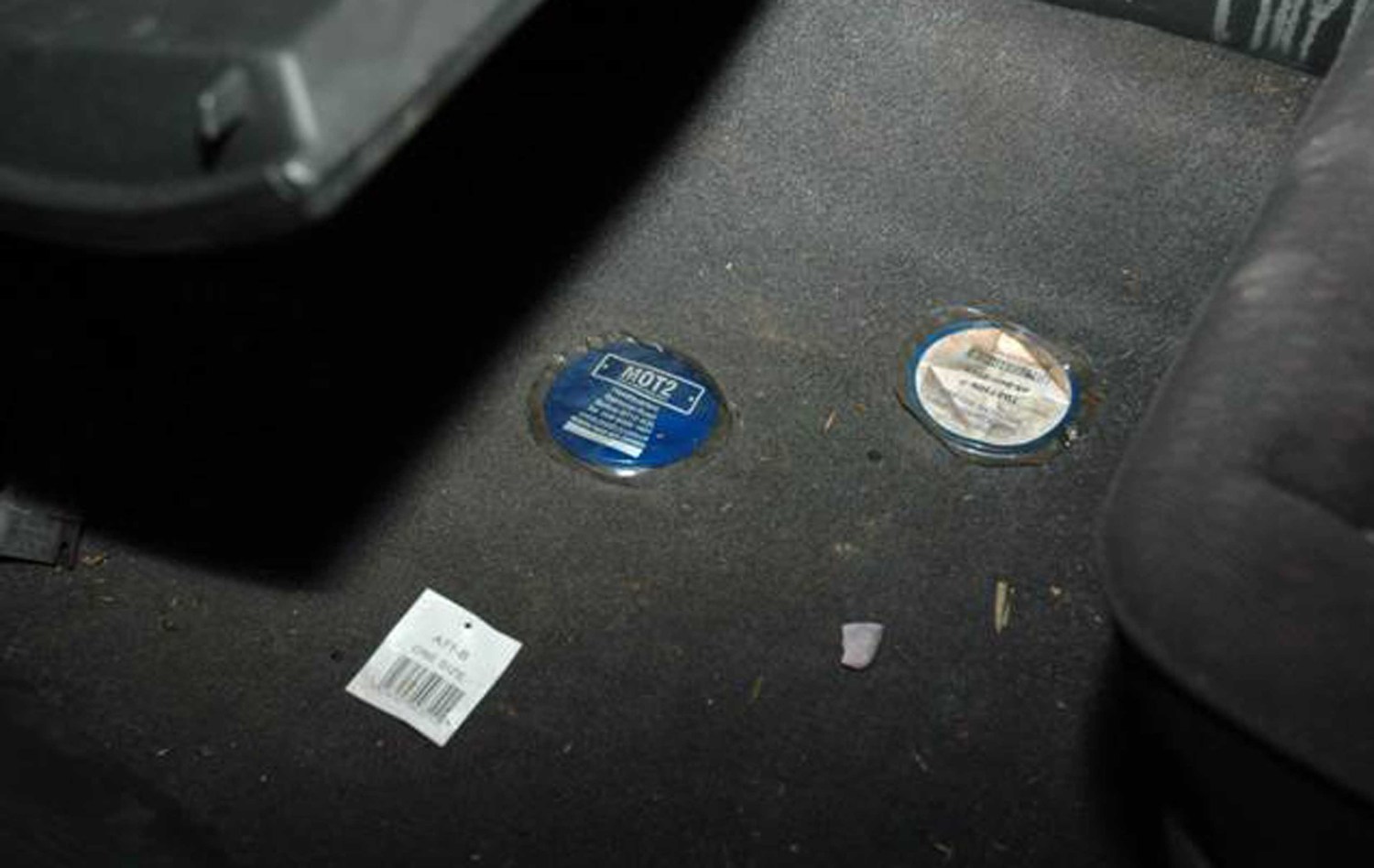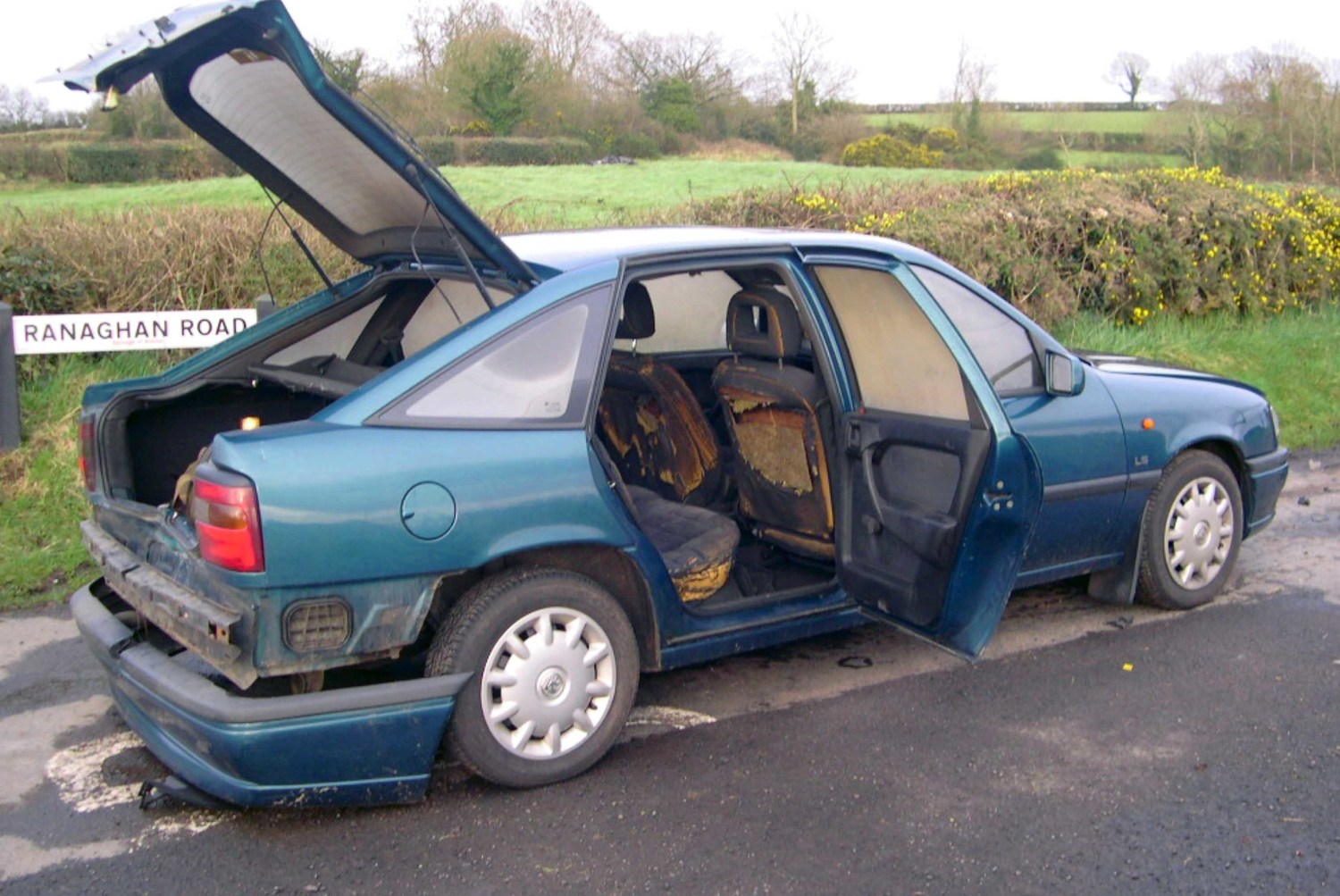The trial of a Co Derry man accused of assisting the killers of two British army soldiers at Massereene has heard police experts concede that crucial evidence may have been contaminated by a failure to properly ensure its forensic integrity.
Magherafelt man Brian Shivers went on trial last week accused of attempting to destroy a getaway car used by Real IRA gunmen who shot dead sappers Mark Quinsey (23) and Patrick Azimkar (21) at Massereene army barracks in Antrim on March 7, 2009.
Potentially crucial forensic evidence was found in the killer’s partially destroyed getaway car, which had been abandoned 7 miles away minutes after the attack.
Mr Shivers was charged with murder after his DNA was allegedly found on two matchsticks discovered on the back seat in the rear of the vehicle.
However on Thursday two PSNI Scenes of Crime Officers (SOCO) confirmed the possibility that the forensic integrity of the two matchsticks could have been compromised as a result of a failure to correctly protect the items during a search of the car and to later individually separate them in different exhibit containers.
On Thursday SOCO examiner Rosemary Johnston told the court that she had been called to the scene where the killers’ partially burnt out Vauxhall Cavalier was found on Ranaghan Road hours after the attack.
Ms Johnston said that as part of her task to recover any potential DNA from inside the vehicle she had been asked to examine a holdall in the boot of the vehicle.
Under questioning from Defence counsel, Orlando Pownall QC, Ms Johnston confirmed that as a result of being unable to open the boot of the vehicle she had lowered the back seats in a bid to recover the holdall.
However the defence argue that Ms Johnston’s failure to protect or remove the crucial matchsticks before lowering the backseat on top of them means their forensic integrity can no longer be guaranteed.
Cross-examining Ms Johnston, Mr Pownall asked: “Did you notice the matches that were on the seat?”
Ms Johnston: “Yes, my Lord, I did notice them.”
Mr Pownall: “I beg your pardon.”
Ms Johnston: “I did notice them.”
Mr Pownall: “Did you not think: well let’s remove those matches before I put the seat down?
Ms Johnston: “No, my Lord, I’m afraid I didn’t consider that at the time.
Mr Pownall: “Well, let’s just consider why that might have been a good idea. Do you think now it might have been a good idea?
Ms Johnston: “Yes, my Lord, I’m afraid at the time I didn’t realise that they could be a potential source for DNA. So I had over looked them.”
Questioned by Mr Pownall if she had not realised that the matches might have possessed crucial DNA, which could have potentially identified the killers, the SOCO examiner said:
“No, my Lord, it’s a little embarrassing but, no, I did not know that they were a potential source for DNA until that time.”
Mr Pownall: “And how long, forgive me for asking, how long had you been a crime scene investigator?
Ms Johnston: “At that stage I was four years.”
Mr Pownall: “You’ve never picked up matches before?”
Ms Johnston: “No, my Lord, I’d never been to a scene where there were matches that were deemed suitable for DNA.”
Mr Pownall: “Or wood?”
Ms Johnston: “No, my Lord.”
Mr Pownall went on: “I’m not going to make a big thing of it, but you are saying, are you, you are inviting this court to accept in 2009 you didn’t believe that matchsticks were good receptors for DNA?”
Ms Johnston: “No, my Lord.”
Mr Pownall: “Or is it the case that though you thought though good receptors for DNA there wouldn’t be much point putting them up because they wouldn’t provide a useful profile?”
Ms Johnston: “No, my Lord, it wasn’t that at all, it was I honestly didn’t realise that I could get DNA from them.”
Mr Pownall: “Which is why you allowed the back of the seat to sit on top of them?”
Ms Johnston: “Yes, my Lord.”
Mr Pownall: “Perhaps causing whatever there was on the back of the seat to impact upon them?”
Ms Johnston: “It’s possible, my Lord.”
Under cross-examination from prosecution counsel, Philip Henry BL, Ms Johnston agreed that she had only lowered one section of the rear seat of the car and that it had not in fact impacted on the matchsticks.
However when Mr Shivers’ defence counsel then produced photographs of the car to show that Ms Johnston had indeed lowered both sections of the back seat, she conceded: “I apologise, my Lord, I have mis-remembered, the other side of the seat was also down.”
Ms Johnston was asked whether she thought it had been correct for a fellow SOCO examiner to have later placed the two crucial matchsticks into the same evidence phial, after they had been recovered from the back seat of the car.
Mr Pownall: “Thinking it through, if two items are put in the same bag, then over the hours or days or maybe more that they spend in that bag being lifted, transferred, they are going to rub off against one another, aren’t they?
Ms Johnston: “Yes, my Lord.”
Mr Pownall: “And there might be transfer?”
Ms Johnston: “It might be possible, my Lord, yes.”
Mr Pownall: “So commonsense dictates, doesn’t it, that now if you were picking up matches you put them in different phials.”
Ms Johnston: “Yes, my Lord.”
SOCO officer Mark Robinson, who recovered the matches from the back seat of the Vauxhall Cavalier, was questioned about Ms Johnston’s decision not to protect the two pieces of forensic evidence prior to lowering the back seats.
Mr Pownall: “Would you consider it to be best practice to leave two matches on the seat of a vehicle and then to bring the back of that vehicle down on top of them?”
Mr Robinson: “No it wouldn’t be.”
Mr Pownall: “And why is that?”
Mr Robinson: “You may disturb them, they may get lost, you may have fibre transfer from the seat back onto the matches.”
Mr Pownall: “Or other sorts of transfer?”
Mr Robinson: “Yes.”
Mr Pownall asked the SOCO examiner if there had been any specific reason why he had not placed the individual matchsticks into separate exhibit containers.
Mr Robinson: “No reason at all, just they were recovered from the same area, so it would be acceptable to put them in the same bag.”
Mr Pownall: “Notwithstanding the fact that one might rub against the other and there might be transfer from one to the other?”
Mr Robinson: “There could have been, but at the time I put them in the same bag.”
The court heard from a third SOCO examiner, John Carson, who confirmed that when he arrived at the scene he had first recovered a petrol canister from a nearby field which had been used by the killers to set the car alight.
The court was told that when Mr Carson then went to examine the getaway car he had stepped into the foot well of the vehicle while recovering two mobile phones from the console of the Vauxhall.
Questioning whether the SOCO examiner’s decision to place a muddied foot inside the car could have compromised potential forensic evidence, Mr Pownall asked: “Did you really put your foot into the foot well?”
Mr Carson replied: “I would have done, yes. It’s very difficult to reach into a vehicle to the centre console whilst trying not to make contact too much with either the interior or exterior of the vehicle without putting your foot inside the vehicle.”
Mr Pownall: “Notwithstanding your undoubted experience Mr Carson, I’m going to suggest that’s nonsense. It was raining, yes?”
Mr Carson: “Yes, it was.”
Mr Pownall: You had over shoes (protective forensic footwear) on?”
Mr Carson: “Yes I did.”
Mr Pownall: “But the verge, and the whole roadway, was wet and muddy, wasn’t it?”
Mr Carson: “It was damp, absolutely, yes.”
Mr Pownall: “And are you seriously suggesting that you plonked one, if not both, of your muddy over shoes into the front footwell of that Cavalier car.”
Mr Carson: “I would have placed one inside it, yes.”
Mr Pownall: “Really?”
Mr Carson: “I believe so.”
Mr Pownall: “Well, that’s a way of compromising a crime scene, isn’t it? Couldn’t you just lean across to the central console and remove those two mobile phones?”
Mr Carson: “Potentially I probably could have, but then again it would – the potential is there I could lose my balance and fall face long into the motor vehicle, which would equally compromise.”
The SOCO examiner was asked if he had changed his protective forensic clothing between the time he had initially recovered the petrol can from the field and placed his foot in the car to remove the mobile phones.
Mr Carson: “I would have changed my gloves, not necessarily my over shoes. I honestly, I have no note of how many times I’ve changed my personal protective equipment.”
Questioned by Mr Pownall if he’d changed his protective over shoes before placing his foot in the car, he replied: “The honest answer is I have no recollection of whether they were changed or not.”
Trial judge Mr Justice Deeny asked: “You said a minute ago that you changed your gloves, implying that you didn’t change anything else?”
Mr Carson: “Well, yeah it would certainly be standard to change my gloves on a regular basis.”
Mr Justice Deeny: “But not standard practice to change over shoes?”
Mr Carson: “No, it is not a practice to change over shoes.”
The court heard that the killers’ getaway car had been removed from the scene by recovery driver Robert Greer.
Mr Greer had originally made a witness statement to police stating that he’d never entered the getaway car at any time during his recovery of the vehicle.
However when his DNA was found on the handbrake of the getaway car he claimed he’d been telephoned by an unnamed individual while he was leaving the vehicle to Maydown Police Station and asked to search the vehicle for a missing exhibit label inside the Vauxhall.
Mr Greer said he couldn’t explain how the unidentified caller could have known if the exhibit label, identifying the Vauxhall Cavalier as the getaway vehicle, was missing when he himself was the only person in possession of the car at the time.
Mr Pownall asked: “Did it not strike you as rather odd that somebody’s ringing you to say that an exhibit label can’t be found, how would they know – how would they know?”
Mr Greer: “I don’t know.”
In January 2010 the recovery driver was questioned under police caution as to whether he had made a false statement when he had initially claimed he’d never been in the car.
No charges were ever brought against him.
Asked by Mr Pownall if he had been “hung out to dry” by police after his DNA was found on the handbrake, Mr Greer replied: “I wouldn’t say that, no.”
The trial continues.



